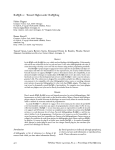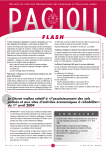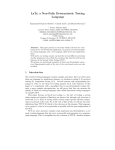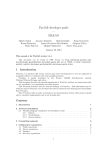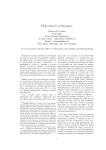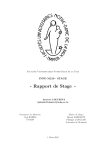Download From stack removing in stack-based languages to BibTEX++
Transcript
From stack removing in stack-based
languages
to BibTEX++
Emmanuel Donin de Rosière
Supervisor : Ronan Keryell
The 28th August 2003
MASTER THESIS
2002-2003
ENST Bretagne
Technopôle Brest-Iroise - CS 83818 - 29238 Brest Cedex
Dedicated to Safaa
iii
RÉSUMÉ
RÉSUMÉ
Dans ce rapport, nous présentons BibTEX++, un logiciel de gestion de références bibliographiques qui essaie de devenir le successeur du très connu
BibTEX. L’un des fonctionnalités les plus interessantes de BibTEX++ est
la possibilité de tranformer les fichiers de style pour BibTEX (écrits en bst)
en fichier de style pour BibTEX++ (qui sont écrits en JAVA). Nous allons
donc expliquer comment nous avons transformé la pile du language bst en
variables JAVA, comment nous avons retrouvé le type de ces variables et
quelles optimizations nous avons utilisées afin de rendre les fichiers de style
compilés les plus compréhensibles possible.
Dans une première partie, nous allons donc présenter quelques concepts
importants, puis expliquer le fonctionnementde BibTEX++ et BiSTrO, le
compilateur bst→JAVA et enfin exposer les différents résultats obtenus.
Mots clefs : BibTEX, langage à pile, optimisations, compilateur, BibTEX++,
bibliographie, LATEX
iv
ABSTRACT
ABSTRACT
In this report, we introduce BibTEX++, a bibliography section creator for
LATEX which tries to become the BibTEX successor. One of the main features
of this software is to compile old BibTEX style files (bst language) to JAVA
code. So, we will explain how we transform the stack of the bst language
into JAVA variables, how we find the type of each element on the stack and
what optimizations we use in order to clarify the output code.
First, we are going to present some important concepts and then explain
how works BibTEX++ and BiSTrO (the bst→JAVA compiler) and finally
show you the results of these softwares.
Keywords : BibTEX, stack-based language, optimizations, compiler,
BibTEX++, biliography, LATEX
v
AKNOWLEDGMENTS
ACKNOWLEDGMENTS
First, I would like to thank all students and researchers which worked on
this project : Laura Barrero, Martin Brisbarre, Laurent Cordival, Fabien Dagnat, Etienne Debenoist, Guillaume Ferrier, Aude Jacquot,
Olivier Muller, Mathieu Servillat, Firass Squalli, Nicolas Torneri
and Emmanuel Valliet.
I also want to express my gratitude to Ronan Keryell for his valuable help
and technical support. He was (almost ?!) always there to listen and help.
vii
TABLE OF CONTENTS
Table of contents
Résumé
iv
Abstract
v
Aknowledgments
vii
Table of contents
x
1 Introduction
1
2 Background
2.1 BibTEX . . . . . . . . . . . . . . . . .
2.2 Stack-Based Language . . . . . . . . .
2.3 BST language . . . . . . . . . . . . . .
2.4 Stack removing in stack-based language
2.4.1 Source-to-source translator . . .
2.4.2 Compiler . . . . . . . . . . . . .
2.4.2.1 RAFTS . . . . . . . .
2.4.2.2 LaTTe . . . . . . . . .
3 BibTEX++
3.1 Presentation of BibTEX++ .
3.2 BiSTrO architecture . . . .
3.2.1 Description . . . . .
3.2.2 The Parser / Lexer .
3.2.3 The Tree translator .
3.2.4 The Optimizer . . .
3.3 Translation . . . . . . . . .
3.3.1 Stack representation
.
.
.
.
.
.
.
.
.
.
.
.
.
.
.
.
.
.
.
.
.
.
.
.
.
.
.
.
.
.
.
.
.
.
.
.
.
.
.
.
.
.
.
.
.
.
.
.
.
.
.
.
.
.
.
.
.
.
.
.
.
.
.
.
.
.
.
.
.
.
.
.
.
.
.
.
.
.
.
.
.
.
.
.
.
.
.
.
.
.
.
.
.
.
.
.
.
.
.
.
.
.
.
.
.
.
.
.
.
.
.
.
.
.
.
.
.
.
.
.
.
.
.
.
.
.
.
.
.
.
.
.
.
.
.
.
.
.
.
.
.
.
.
.
.
.
.
.
.
.
.
.
.
.
.
.
.
.
.
.
.
.
.
.
.
.
.
.
.
.
.
.
.
.
.
.
.
.
.
.
.
.
.
.
.
.
.
.
.
.
.
.
.
.
.
.
.
.
.
.
.
.
.
.
.
.
.
.
.
.
.
.
.
.
.
.
.
.
.
.
.
.
.
.
.
.
.
.
.
.
.
.
3
. 3
. 3
. 5
. 8
. 8
. 12
. 12
. 13
.
.
.
.
.
.
.
.
15
16
17
17
18
21
21
22
22
.
.
.
.
.
.
.
.
ix
TABLE OF CONTENTS
3.4
3.5
3.3.2 Built-in functions . . . . . . .
3.3.3 Type inference on stack item .
3.3.4 Return parameters . . . . . .
3.3.5 Control structures . . . . . .
3.3.6 Unknown stack depth . . . . .
Optimizations . . . . . . . . . . . . .
3.4.1 Copy propagation . . . . . . .
3.4.2 Constant propagation . . . . .
3.4.3 Dead code elimination . . . .
Security . . . . . . . . . . . . . . . .
.
.
.
.
.
.
.
.
.
.
.
.
.
.
.
.
.
.
.
.
.
.
.
.
.
.
.
.
.
.
.
.
.
.
.
.
.
.
.
.
.
.
.
.
.
.
.
.
.
.
.
.
.
.
.
.
.
.
.
.
.
.
.
.
.
.
.
.
.
.
.
.
.
.
.
.
.
.
.
.
.
.
.
.
.
.
.
.
.
.
.
.
.
.
.
.
.
.
.
.
.
.
.
.
.
.
.
.
.
.
.
.
.
.
.
.
.
.
.
.
.
.
.
.
.
.
.
.
.
.
.
.
.
.
.
.
.
.
.
.
23
25
27
27
27
28
28
29
29
30
4 Results
31
4.1 Speed and execution time . . . . . . . . . . . . . . . . . . . . 31
4.2 BibTEX++ styles and optimizations . . . . . . . . . . . . . . . 33
Conclusion
37
Appendices
41
A bst grammar
41
B Error in format.names
47
Bibliography
50
x
CHAPTER 1. INTRODUCTION
Chapter 1
Introduction
A bibliography or list of references is a listing of all sources from which you
have taken information directly (by literal quotation) or indirectly (through
paraphrase), or where you have used information or reproduced material
from. These references are used to :
➥ Clearly identifying each document. So it provides some identification
elements to allow the reader to search these documents in librairy catalogues or anywhere else. In most cases, these identification elements
are normalized [10] (we often use the name of the book, the author, the
editor, ...), but because of the numerical revolution, there are more and
more document types (web pages for example) and identification elements (e-mail, URL . . . ). So the management of the references became
more and more difficult.
➥ Enable the reader to consult the sources you have used with a minimum
of effort. So we have to indicate precisely where (on which page, the
electronic location) or under which circumstances (personal interview,
e-mail) you obtained the information.
But, creating a bibliography has always been an headache for typographers : if the article said [12] is a book about meta-middleware and in
the bibliography [12] is a cook book, there has been a problem somewhere.
Another problem is each journal has its own bibliographic style, so a bibliographic management software has to allow the user to create his own style
and send it to other people.
Today, everybody mostly use only one bibliographic software for LATEX :
it’s BibTEX [16]. But it hasn’t changed for ten years, so it can’t use modern
1
CHAPTER 1. INTRODUCTION
encoding (such as unicode UTF-8) and the BibTEX style language is not
very expressive. Today, there are only few people that are able to create new
styles from scratch. It’s in this context that the project BibTEX++ takes
place. It tries to be his successor with more features but fully compatible
with BibTEX.
In order to continue this project, I realized a master thesis at the computer
science department of the ENST Bretagne (the National Telecommunication
Engineering School of Brittany) in France. My supervisor in this project
was Ronan Keryell, an assistant professor at the Laboratory of Computer
Science and Telecommunications (LIT) in this school.
2
CHAPTER 2. BACKGROUND
Chapter 2
Background
2.1
BibTEX
BibTEX is a popular tool used by the LATEX [8] community to generate
bibliographical notices in publications. It suites very well the LATEX philosophy and is well integrated to it : the user describes his wishes with a mark-up
language but not the layout details : the LATEX infrastructure will use some
styles to typeset the presentation from the high level content description.
The citation matter is stored in a database (a file with a .bib extension)
and BibTEX picks from the .aux file the needed information according to
the citation marks placed in the LATEX document (.tex file) by the author. A
typeset version of the bibliography is done by bibTEX to the .bbl file by using
a .bst bibliography style file. The work-flow is summed up on figure 2.1 [8].
2.2
Stack-Based Language
BibTEX bst files use a stack-based language : it is a type of language
where you have to put data you want to use in a stack. Functions store
their results in this stack (in fact we use an inversed polish notation -IPNor postfix notation ). For example, if you want to do 2 + 3, you have to
put 2 and 3 on the stack and then call the add operor, so you have to write
something like : 2 3 +.
Stack-based languages are sometimes used as programming languages but
they are more popular as intermediate languages for compiler and as machineindependent executable program representations. Here is a list of stack-based
3
CHAPTER 2. BACKGROUND
Figure 2.1: BibTEX Work-flow
languages :
Programming languages
➥ Forth is used in many fields, especially in embedded control applications.
➥ PostScript is used primarily in typesetting and other display
purposes. But because the majority of PostScript code is written
by programs, it can also be regarded as an intermediate language.
➥ RPL (reverse polish LISP) is the language of the HP-48 calculator; It’s a run-time type-checked language with mathematical
data types (it’s on a calculator) and Forth-like syntax.
➥ The BibTEX style language or bst language is a stack-based
language for processing BibTEX databases.
Itermediate language
➥ UCSD p-code is used in the UCSD system, an operating system
well-known for its Pascal compiler. P-code was either interpreted
or compiled to native code. We can find today p-code compilers
for more recent system.
4
CHAPTER 2. BACKGROUND
➥ Smalltalk-80 byte code is the intermediate language of the
Smalltalk-80 system.
Machine-independent language
➥ JAVA bytecode is the code you obtain after compiling a JAVA
file. It can be used on every system supported by JAVA because
it will be interpreted by the JAVA Virtual Machine.
But computers are mainly register machines, so it’s not easy to implement
a stack-based language. That is why stack-based language are not frequently
used. Today, there are 3 ways to execute a stack-based language on a register
machines :
➥ Using an interpreter. At the execution, it will transform each instruction into a mnemonic one. The execution is dynamic but very slow.
➥ Using a compiler. It will statically transform the code into mnemonic
one.
➥ Using a source-to-source translator which converts stack-based code
into a high-level language and then compiling the output code. It
allows the code to be executed in lots of different systems if the highlevel language is well-known and used.
2.3
BST language
We have already seen that the bst language is the Style language for
BibTEX. But it uses a specifical syntax that we will see here. A style file is
program which formats the reference list in a certain way. For example, a
style file can sort the reference list by alphabetical order thanks to the autor
names and makes the title in italics. BST language uses ten commands which
manipulate language objects : constants, variables, functions, the stack and
the entry list (the reference list). A string value is between double-quotes
like "abcd efgh" and an integer is preceded by an # like #23. There are also
three different types of variables :
➥ Global variables which are declared by an INTEGERS or STRINGS comand.
5
CHAPTER 2. BACKGROUND
➥ Entry variables which can be strings or integers, but a value is assigned
for each entry of the list.
➥ Fields which are read-only strings. They represent information from
the curent reference item, so each one has a value for every entry.
These ten commands are :
➥ ENTRY which declares the fields (in the bibliography databases) and the
entry variables. crossref is a field which is automatically declared
(used for cross referencing) and sort.key$ is an entry variable (used
for sorting references) also automatically declared.
➥ EXECUTE which executes a function. It takes one argument : the function name.
➥ FUNCTION which declares a new function. It takes two arguments : the
function name and its definition. You have to declare a function before
using it. So there is no recursion inside a bst file.
➥ INTEGERS which declares new integer global variables. entry.max$ and
global.max$ are automatically declared (used for limiting the size of
the strings).
➥ ITERATE which executes a single function for each entry in the reference
list. These calls are made in the list current order.
➥ MACRO which defines a string macro. The first argument is the name of
the macro and the second is the text remplacement. Each occurrence
of the name of the macro will be replaced by the second argument. It’s
usefull for month abbreviation for example.
➥ READ which reads the database file and assigns to fields their value for
each entry.
➥ REVERSE which performs the same action than ITERATE but in reverse
order.
➥ SORT which sorts the reference list in alphabetical order according to
sort.key$.
➥ STRINGS which declares new string variables.
6
CHAPTER 2. BACKGROUND
All these commands permit to define the structure of a style file. But with
them, we can not manipulate variables. It is why some built-in functions have
been declared in BibTEX. There are 37 functions so we won’t see each of them,
but only the most important. If you want to know more, read BibTEXing
written by Oren Patashnik [16]. The most important built-in function are :
<, <, =, + and - which manipulate integer variables and constants. In the
BST language there is no boolean, so we use 1 when something is true
and 0 otherwise.
* which concatenates two strings.
:= which assigns to the first literal the value of the second.
call.type$ which executes the function whose name is the entry type of the
entry. For example, it calls the function book if the entry is a book. . .
It is often associated with the ITERATE command.
format.name$ which pops the three tops literals from the stack. The last
literal is a name list, so this function will format a name in this list
with the specification of the first string.
if$ which pops three literals. If the last is greater than 0, the second literal
is executed else the first.
skip$ which does nothing (usefull for creating if$ empty branch).
while$ which pops two literals and keeps executing the second as long as
the first literal puts on the stack is greater than 0.
write$ which writes the top string item into the bbl file (the output of
BibTEX ).
With all these build-in functions, we can create new function a bit more
sophisticated like this one :
FUNCTION {and}
{
’skip$
{ pop$ #0 }
if$
}
7
CHAPTER 2. BACKGROUND
This function calculates the “logical and” between two numbers : if the
first element on the stack is greater than 0, skip$ is executed so this function
returns the second element on the stack. Else, pop$ #0 is executed which
puts 0 on the stack. We can see even with this oversimplistic example that
it is not easy to understand BST language :
➥ We are not accustomed with this postfix notation.
➥ The number and the type of input and output variables are implicit.
➥ We have to read all the control structure in reverse order.
It’s why only few people are able to program a new style in this language.
So for BibTEX++, we will have to create a style language more expresssive.
But, because of the need of compatiblity with BibTEX, we’ll have to transform
this stack-based language into a standard one. So we will see how to remove
the stack in a stack-based language.
2.4
2.4.1
Stack removing in stack-based language
Source-to-source translator
There are only few source to source translators for stack-based language.
The most famous research on this was made by M. Anton Ertl (the author of A New Approach to Forth Native Code Generation [6]). During his
PhD Thesis [5], he tried to transform Forth code into C language in order
to increase the portability of Forth applications. Actually, if you want to
use a Forth application on a special system, you have to develop a special
interpreter. However, if you transform the Forth into C, it must be used on
every system (because there is often a C compiler available). And you don’t
even need to optimize the C code because the C compiler will do that !
Practically all the other source to source translators for stack-based language are JAVA decompilers like : krakatoa [17] or mocha [18] which try to
transform JAVA bytecode into Java. With this, you can obtain the sources
of a program from compiled files. Nevertheless, all these translators use the
same algorithm and special optimizations for JAVA and JAVA Bytecode. So
we will only look at the M. Anton Erl one (this translator is called f2c).
f2c uses several steps to convert Forth code to C language. The first one
is to split the code into its functions which will be processed independently.
8
CHAPTER 2. BACKGROUND
Then, f2c counts for each function the number of input and output parameters. The next step is to convert the elements on the stack into C’s local
variables with the notation of the figure 2.2.
Figure 2.2: Relation between C variables and the stack.
So, p0, p1. . . represent the entry variables of each function and x0, x1. . .
are used like local variables. This scheme ensures that stack items that are
not affected by an operation do not have to be copied around between local
variables.
Then f2c converts each Forth primitive into a C’s sequence. For exemple,
if the top of the stack resides in x1, the translation of + will look like :
{
Cell n1=x1;
Cell n2=x0;
Cell n;
n = n1+n2;
x0=n;
}
/* top of the stack now: x0 */
This sequence is very long, but a good C compiler can compile it to only one
instruction (sometimes, it can convert severals sequences into one instruction). So the translation always works like this :
9
CHAPTER 2. BACKGROUND
➥ All the usefull elements are declared as C’s local variables and are
initialized.
➥ We copy the C code for the Forth primitive.
➥ The result variables are copied back to the stack.
f2c has also to convert all the control structures. But Forth allows the
creation of arbitrary control structures so it is easier to convert them into
gotos and labels C instructions.
Forth control Word
Meaning
IF
conditional forward branch
AHEAD
unconditional forward branch
THEN
target of forward branch
BEGIN
target of backward branch
UNTIL
conditional backward branch
AGAIN
unconditional backward branch
C traduction
if (x ==0) goto label ;
goto label ;
label :
label :
if (x ==0) goto label ;
goto label ;
Table 2.1: Forth control structures and their C traduction
Nevertheless, this translation mechanism needs to know the height of the
stack everywhere in the Forth code, but it’s not always possible. Sometimes
the stack depth is unknown. For exemple, in the case of an instruction like
?DUP 0= IF which means that if the top of the stack is 0, we remplace it
with the previous element on the stack, else we delete the element. So in this
case, f2c has to create a C stack and uses it in the whole function.
f2c can easily convert a Forth program into a C one, but the output code
is often not very expressive : for exemple the next Forth function which
calculates the maximum between two numbers
2dup < if
swap drop
else
drop
endif
will be converted by f2c into :
10
CHAPTER 2. BACKGROUND
Cell max(Cell p0, Cell p1)
{
/* stack now: ... p1 p0 */
{
/* 2dup */
Cell n1,n2;
n1=p0;
n2=p1;
p1=n2;
p0=n1;
x0=n2;
x1=n1;
}
/* stack now: ... p0 x0 x1 */
{
/* less than */
Cell n1,n2,n;
n1=x1;
n=FLAG(n2<n1);
xo=n;
}
/* stack now: ... p0 x0 */
if (!x0) goto label0;
/* stack now: ... p1 p0 */
{
/* swap */
Cell n1,n2;
n1=p0;
n2=p1;
p1=n1;
p0=n2;
}
/* stack now: ... p1 p0 */
{ /* drop */
}
/* stack now: ... p1 */
goto label1;
label0:
/* stack now: ... p1 p0 */
{
/* drop */
}
/* stack now: ... p1 */
label1:
11
CHAPTER 2. BACKGROUND
/* stack now: ... p1 */
{
/* exit */
_c_result=p1;
return (_c_result);
}
}
In this example, we can see that the output code is not very clean. But
with f2c, the C language is more essn as an intermediate languague than as
a programmer one because the aim of f2c is not to produce a beautiful code
but an easily optimizable one. With only a copy propagation optimization
this code becomes clearer. In f2c, it’s the C compiler which has to do this,
but it’s not always the case for every source-to-source translator.
2.4.2
Compiler
Source-to-source translators are not the only softwares which remove the
stack in a stack-based language. Stack-based compilers do the same thing,
but they convert this language into a low level one (it’s often into mnemonic
instructions). So their algorithm must be useful for us. We will only see two
examples (RAFTS, a Forth compiler and LaTTe a JAVA Bytecode compiler).
2.4.2.1
RAFTS
RAFTS [6] is a framework for compiling Forth code. It tries to produce
fast and efficient code, so it needs to use some optimization techniques and
interprocedural register allocation to eliminate nearly all stack accesses because they slow down the execution of the program. RAFTS compiles all of
Forth, including unknown stack heigths.
RAFTS uses several steps to compile Forth code. The first step is to split
the code into basic blocks. A basic block is a set of instructions which only
contains simple primitives like literals, constants, variables, +, ! and stack
manipulation words. So a basic branch does not contain any branch or jump
: all primitives are executed sequentially. Then RAFTS builds a data flow
graph of this basic block (see figure 2.3).
Just after that, it converts Forth primitives into mnemonic instructions
and transforms all stack items into unlimited pseudo-registers. So all stack
accesses within a basic block have been eliminated and the DAG is now an
instruction DAG (see figure 2.3). Then an instruction scheduler orders the
12
CHAPTER 2. BACKGROUND
Figure 2.3: RAFTS conversion steps for a basic block
nodes of the instruction DAG, i.e. it transforms the DAG into a list. This
list is optimized for reducing register dependencies between instructions.
Now, we have a set of mnemonic blocks, but we have to connect them
thanks to control structures. Control flow splits (IF, WHILE and UNTIL) are
easy to transform but control flow joins (ENDIF and BEGIN) are a little harder
because the corresponding stack items of the joining basic blocks usually do
not reside in the same register. So RAFTS needs to move some values around
to have the same structure.
In order to have a faster output code, three good register allocation algorithms are proposed : Graph coloring register allocation [2], hierarchical
graph coloring [3] and interprocedural allocators [4].
2.4.2.2
LaTTe
Today, we need faster and faster execution for our JAVA applications.
Higher JAVA performances can be achieved by Just-In-Time (JIT) compilers
which translate the stack-based bytecode into register-based machine code.
One crucial problem in JAVA JIT compilation is how to map and allocate
stack entries and local variables into registers efficiently and quickly as to
improve the JAVA performance.
LaTTe [19] is a JAVA JIT compiler that performs fast and efficient register mapping and allocation for SPARC machines. LaTTe converts JAVA
bytecode (a stack-based language) to SPARC mnemonic. It uses severals
13
CHAPTER 2. BACKGROUND
steps for this :
➥ First, LaTTe identifies all control join points and subroutines in the
JAVA bytecode via a depth-first traversal in order to build a control
flow graph (CFG).
➥ Then, it converts this bytecode into a CFG of pseudo SPARC instructions with symbolic registers.
➥ Optionally, some traditional optimizations are performed.
➥ In the fourth step, LaTTe performs a fast register allocation, generating
a CFG of real SPARC instructions.
➥ Finally, the graph is converted into a list of SPARC instructions.
In order to transform the stack into registers, LaTTe uses symbolic pseudoSPARC registers whose names are composed of three parts :
➥ The first character indicates the type : a for an address (object reference), i for an integer, f for a float, l for a long and d for a double.
➥ The second character indicates the location : s for operande stack, l
for local variable and t for temporary variable used by LaTTe.
➥ The remaining number distinguishes the symbolic registers.
For example, il2 represents the second local integer register. But at the end
of the algorithm, LaTTe transforms these pseudo-registers into real ones.
To do that so as to increase performance, LaTTe uses two passes for each
An extended ba- extended basic block :
sic block is a tree
➥ The backward sweep algorithm is a post-order traversal which colregion which has
lects information on the preferred destination registers for instructions.
a single entry but
➥ The forward sweep algorithm is a depth-first traversal which permultiple-exit subforms the real register alloation using that information.
graphs like tree
Sometimes, we need to move register in order to reconciling register allocation at region join points because LaTTe use these two algorithms on each
extended basic block independently. So two blocks may not use the same
register for the same item on the stack.
This method is very efficient : the output code of LaTTe is on average
two times faster than with the SUN JIT and this speed comes particularly
from the register allocation algorithm.
14
CHAPTER 3. BIBTEX++
Chapter 3
BibTEX++
As we have seen in the section 2.1, BibTEX is a very good tool to produce
bibliographies but it begins to become old : it was created during the 80’s
and the last modification was the management of 8 bit characters in 1990.
Today, the LATEX community needs lots of new functionnalities like :
➥ Multilingual bibliography. It’s easier and easier to obtain documents
from foreign countries, so, sometimes, we have to deal with bibliography
which contains references with asian or arabic characters.
➥ Access to bibliography databases from the Internet. Lots of them are
available on the net [13] so it would be better if the tool connects
automatically to an online database and recovers temporarily all useful
references.
➥ Style programming language more expressive. Today, there are only few
people that are able to create a new bibliography style or to understand
an old one. We’ve already seen how weird is the bst language.
➥ A software which can easily evolve. In the future, we might need new
features and it will be a shame to rewrite a newBibTEX-like tool.
➥ Compatible with BibTEX. Lots of stuff had been written for BibTEX
like styles, bibliography databases. . . so it’s better if this new tool can
use them.
It was in this context that the project BibTEX++ was born.
15
CHAPTER 3. BIBTEX++
3.1
Presentation of BibTEX++
One of the most constraint for BibTEX++ is the compatibility with
BibTEX, so its architecture must look like BibTEX one. But we also need to
easily change the comportement of BibTEX++, in particular the input and
output data. So we arrive at a structure like the figure 3.1.
Figure 3.1: BibTEX++ Workflow
The aim of this structure is to change all file formats with a BibTEX++
plugin. For example, there are lots of different formats for bibliographic
databases (tib format, XML . . . ), so with a plugin, we will be able to use a
.xml instead of .bib. This plugin will contain an XML parser/lexer and a tool
which converts the syntaxical tree of the .xml file into an internal BibTEX++
database object. It will be the same thing for style files and input files, so
BibTEX++ may become a bibliographic software for LATEX and Micro$oft
Word.
Precisely, we need a language for the bibliography style. But there are
lots of constraints :
➥ A well-known language (not like weird bst one).
➥ With UNICODE, network. . . support.
➥ That can deal with big programs.
16
CHAPTER 3. BIBTEX++
➥ Portable, LATEX is almost present on every architecture.
It is why JAVA has been choosen for both style and software language. So, to
obtain compatibility between BibTEX and BibTEX++, we need to transform
bst programs into JAVA ones.
3.2
BiSTrO architecture
The main part of my work during this application was to create the
software which will transform a bst style file into a JAVA one. This software
is called BiSTrO (BibTEX Style Translator and Optimizer). One of the aims
of this is to enable BibTEX++ users to easily write new styles or modify
existant ones. So the JAVA generated styles must be easily comprehensible
because they will be used as skeleton for new styles.
But all the source-to-source translators or compilers in section 2.4 try to
optimize the output in order to speed up the execution, but we need here
to increase clearness. So just after the transformation into JAVA, we will
have to add some optimizations to increase it. But, depends of its use the
BibTEX++ compiler will need speed or optimization.
If someone just wants to use BibTEX++ with an old BibTEX style, he
will never look at the generated JAVA file, but he can be impatient. In this
case, we will remove these optimizations and also use a JAVA cache to stock
all the JAVA Style already created by BibTEX++.
But if someone just wants to create a new JAVA style based on a bst
old one, he will want to understand the style file. In this case we will have
to optimize the output code and to enable users to only use the BibTEX++
style compiler.
3.2.1
Description
In thinking at all these constraints, we create BiSTrO (Bibtex Styles
Translator and Optimizer) with the architecture on figure 3.2. biSTrO is
composed by four components that we will see more in details in the next
sections :
The Lexer/Parser : it transforms the .bst file into a bst Abstract Syntax Tree (AST) in order to be easily analysed. This parser had been
generated by SableCC [7] with a home-made bst grammar.
17
CHAPTER 3. BIBTEX++
Figure 3.2: BiSTrO Architecture
The Tree translator : first, it makes several passes in the bst AST in
order to obtain information about bst functions, elements on the stack
and possibility to remove the stack. Then, it converts the bst AST into
a JAVA AST.
The JAVA optimizer : it modifies the JAVA tree in order to optimize the
legibility of the generated code. It uses several independent optimizations to allow the user to choose which optimizations he wants to use
at the time of the execution.
The Pretty Printer : it transforms the optimized (or not) JAVA tree into
a real JAVA file. It also indents this code to increase its legibility.
3.2.2
The Parser / Lexer
There are only few compiler compilers which allow to create Abstract
Syntax Tree (AST). Most of them, execute an action code as soon as the
generated parser discovers an element of the grammar (like YACC [11] and
JAVA CUP [9] for example). So it’s difficult to generate multiple pass compilers with these compiler compilers without rebuilding an AST. For JAVA,
the most known which permits to create AST is ANTLR2.xx [15], a JAVA
implementation of PCCTS [14].
Nevertheless, ANTLR lexer does not support 16 bits unicode character
input. It is why we chose here the SableCC framework [7]. SableCC sits in
the middle between front-end compiler compilers (a lexer plus a parser) and
end-to-end compiler compilers which provide complete compilers. We chose
it because it has lots of useful features like :
18
CHAPTER 3. BIBTEX++
➥ It separates machine generated code and human written code. This
simplifies the maintenance of BiSTrO.
➥ We don’t need runtime library at the execution (unlike JAVA CUP [9]).
So users of BibTEX++ only need a recent JAVA virtual machine.
➥ It is free and under Lesser General Public License (LGPL). The source
are also availabled on SourceForge (http://sourceforge.net/projects/
sablecc/).
➥ It creates at the same time the lexer and the parser.
➥ The parser automatically builds the AST of the compiled program and
the node classes are created during the compilation of this parser.
So, to generate this lexer/Parser we only need to create the bst grammar
file. SableCC also automatically provides an AST analyser to helping the
development of the next step of a compiler : the analyser.
The syntax of the grammar file is really easy to understand. It contains
up to six parts (all of them are optional) :
package declaration : it specifies the root package for all classes generated
by SableCC.
helper declaration : a helper is a character set or a regular expression
denoted by an identifier. When SableCC sees a helper identifier in a
regular expression, it replaces it semantically by its definition.
states declaration : it contains the name of each state used in the token declaration.
token declaration : it contains all the definitions of the token used by the
lexer. We can use states (like in GNU FLEX ) in order to restrict some
use of tokens.
ign tokens : it is the list of the tokens that are ignored by the parser.
production : it is where we declared all the grammatical rules between tokens.
You can find the complete grammar for the bst language in the appendix A, but in order to show you a real example, this is the grammar
file for the .aux file :
19
CHAPTER 3. BIBTEX++
Package auxi;
Helpers
unicode = [0..0xffff];
lf = 10;
cr = 13;
bs = 92;
eof = 0x1c;
line_terminator = lf | cr | cr lf | eof;
all = [unicode - [cr + lf]];
ident_char = [unicode - [’{’ + [cr + lf]]];
info_char = [ident_char - [’}’ + ’,’]];
command = bs ident_char*;
States
init, bibinfo, junk;
Tokens
{bibinfo} comma
= ’,’
;
{bibinfo} info
= info_char+ ;
{bibinfo} l_brace
= ’{’
;
{bibinfo -> junk} r_brace
= ’}’
;
{init -> bibinfo} citation = bs ’citation’ ;
{init -> bibinfo} bibdata
= bs ’bibdata’ ;
{init -> bibinfo} bibstyle = bs ’bibstyle’ ;
{init -> bibinfo} biblang
= bs ’select@language’ ;
{init -> junk} ident
= command;
{junk -> init} forget
= all* line_terminator+;
Ignored Tokens
forget,ident;
Productions
expr_list = expr+;
expr =
{citation} citation l_brace info r_brace|
{bibdata} bibdata l_brace args r_brace|
{bibstyle} bibstyle l_brace info r_brace|
{biblang} biblang l_brace args r_brace;
args = info args_end*;
args_end = comma info;
20
CHAPTER 3. BIBTEX++
3.2.3
The Tree translator
The advantage of having an AST at the exit of the parser is the possibility
to analyse the code with several passes. In order to make this easier, SableCC
creates, when you compile the parser/lexer, several analysers for your specific
AST. When you want to create your own one, you only have to extend yours
from an existent one and change the behavior of some functions. There are
three functions per node : one which is executed before entering in a node,
one after and one inside.
The aim here is to transform this bst tree into a JAVA one. So we need
information to do that, it is why we make several passes. So we use several
analysers to do this :
ParseFunc.java : It searchs information about functions in the bst tree. For
each function, we try to obtain the name of the function, the number of
input and output parameters and the possibility of removing the stack
in this function : it is not always possible (see section 3.3.6).
ParseVar.java : It tries to find the type of the arguments of all functions.
When it can not find this type, it indicates that we will have to use a
polymorphic Cell object which can be either a string or an integer.
ParseDeclaration.java : It analyses the body of the function and the stack
to find how many JAVA local variables we will have to use and what is
their type.
OutFunc.java : With all this information, it transforms into JAVA functions
where we can remove the stack with local variables instead of stack
items.
OutStack.java : It transforms into JAVA functions where we can’t remove
the stack. But the bst stack is replaced by a JAVA stack.
So just after these four passes, we have a JAVA abstract syntax tree, but this
code is not optimized at all, so we need to clarify it a little. It is why we use
an optimizer.
3.2.4
The Optimizer
We decided to use several types of optimizations which are independent
in order to provide a final optimization which is fully customable by the
21
CHAPTER 3. BIBTEX++
user. But we do not need very complex optimizations because the aim of
this is to increase the legibility and not speed the execution. Another reason
for using simple optimizations is that the input code was written by human
programmers in a not very understandable language, so they tried to write
this code properly.
We just use eight different functions in order to do that :
An if optimizer : it just removes all the empty then or else blocks.
A copy and constant propagation : we can see in the example section 3.3.2
page 24 that the non-optimized output code contains lots of useless
variables because there is a variable for each element on the stack. It
will increase the quality of the next dead code elimination.
A dead code elimination : associate with the propagation optimization,
it removes lots of useless definitions, because it deletes all write after
write dependencies.
A boolean translator : in bst language, we don’t have any boolean type,
so this optimization tries to transform integer into boolean in if and
while conditions. For exemple, it will transform if( BuiltIn.equal(
i1 , i2 ) > 0 ) to if( i1 == i2 ).
Some other small optimizations : like peep-hole optimization and poorman partial evaluation : transforming a1 = a0 + 0; into a1 = a0;
or ‘‘some’’+‘‘thing’’ into ‘‘something’’. . . These optimizations
only try to increase the legibility on the JAVA code.
3.3
Translation
With all these steps, we succeed in transforming bst language into JAVA,
but we will see in the section what are the convention we use in this transformation and the difficulties we met.
3.3.1
Stack representation
In all functions without unknown stack depth, we transform the stack in
JAVA local variables in order to simplify the notation and increase the clarity
of the output code. In bst language there are two different types of items on
22
CHAPTER 3. BIBTEX++
the stack : string and integer which are implicit. Outside of the stack there
are lots of other variables (see section 2.3), but we can use for them their
name in the bst language. However the elements on the stack don’t have any
name, we have to find one in JAVA.
Thus in JAVA, we use three types of local variables : String, int and
Cell which is a polymorphic object (it can be a string or an integer depending
of the context). We use this Cell when BiSTrO fails to find the original type
of an element.
The name of a local variable is composed of two parts : the first letter
indicates the type of the variable (s for String, i for int and c for Cell).
The second part is a number which indicates the height of the element in
the local stack (the deepest element of the function uses the number 0). The
input paramaters use the same notations (see figure 3.3).
Figure 3.3: Variable notations in BiSTrO
3.3.2
Built-in functions
We have already seen that we can use 37 built-in functions in BibTEX for
writing new styles. Some of these functions can easily be transformed into
23
CHAPTER 3. BIBTEX++
JAVA ones (+ for example), but it is more difficult for other functions (like
format.name$ which formats a name inside a name list). So, for all these
functions, we create a class which contains the JAVA code of them. The
generated code only calls these functions.
For example, the translation of this bst function :
FUNCTION {format.lastchecked}
{ lastchecked empty$
{ "" }
{ inbrackets "cited " lastchecked * }
if$
}
will be (without optimizations)
public String format_lastchecked( )
{
String s0 , s1;
int i0;
s0 = lastchecked;
i0 = BuiltIn.empty( s0 );
if( i0 > 0 )
{
s0 = "";
}
else
{
inbrackets( );
s0 = "cited ";
s1 = lastchecked;
s0 = s0 + s1;
}
return( s0 );
}
We can see in this small example that BiSTrO can transform a bst function in a JAVA one. Some built-in functions (like empty$) are converted into
calls for home-made function (here BuiltIn.empty) and other (like * which
concatenates two strings) are directly converted in JAVA (in +). We can also
24
CHAPTER 3. BIBTEX++
note here the usefulness of the optimizations. Indeed, this JAVA function is
not very easy to understand but if we use our optimizations, the output will
be something more understandable :
public String format_lastchecked( )
{
String s0;
if( BuiltIn.empty( lastchecked ) > 0 )
{
s0 = "";
}
else
{
inbrackets( );
s0 = "cited " + lastchecked;
}
return( s0 );
}
3.3.3
Type inference on stack item
In the previous example, we can see that the type of all stack elements
and return parameters were found. It is easy to find their type because they
really represent items on the stack. There are only four ways to put an
element on the stack in bst language :
➥ Write its value, like ‘‘cited’’ or #21, and we know immediately the
type of this object.
➥ Write the name of a global variable or field, but when you declare these
elements, you have to indicate their type, so it is not a problem.
➥ Use a built-in function, but BiSTrO knows the return parameter type
of all these functions.
➥ Use a home-made function, and you have just to iterate the algorithm
to find its return type.
Therefore the type of all these object are not very difficult to find :
BiSTrO find them in only one pass, because in bst language, a function
25
CHAPTER 3. BIBTEX++
have to be declared before being used. But it is more difficult to find the
type of the argument of a bst function because, on the one hand, we don’t
know (in the function) where these elements were put on the stack (so we
can’t use the previous method) on the other hand, some function can take
enter variables which can be of different types. For example, in bst language,
we can create a function which takes two parameters. If the first argument is
the string ‘‘integer’’ then the second argument is an integer and we add 5
to it, else we return the number of letters of the second argument (which is a
string). So, sometimes we will not be able to find the type of each parameter
and we will have to use the Cell polymorphic object.
For these reasons, BiSTrO use an algorithm which is quite similar to the
first one, but in the reverse order. We use the entry parameters of functions
(built-in or home-made) to find the type of the arguments. For example, if a
function takes only one argument and the first primitive is write$, BiSTrO
will deduce that this argument is a string. But there are some functions
which modify the stack (duplicate$, pop$ and swap$), so BiSTrO uses
some abstractions to indicate where are the entry parameters on the stack
(see figure 3.4)
Figure 3.4: Finding input types
26
CHAPTER 3. BIBTEX++
3.3.4
Return parameters
In bst language, you can put how many elements you want in the stack,
so there are functions that return more than one element in the stack. But
it is not possible to do it in JAVA (functions can only return zero or one
variable). To correct it, BiSTrO puts all these variables in a Vector, and
when another function calls this one, we just have to extract the variables
from the Vector.
3.3.5
Control structures
In bst language, there are only two types of contol structures : if$ and
while$. So BiSTrO just need to convert them into JAVA while and if
structure. But sometimes, you do not have the same stack state if you execute
a branch or the other inside an if$. Just after this condition structure,
the state of the stack is unknown (we do not know the stack depth or the
type of an element without some very advanced abstract interpretation),
consequently we can not use traditionnal transformations in this function.
So we will see in section 3.3.6 how we transform these functions.
Another problem of the same type is when inside a while$ block, you
put (or remove) an element in the stack. Depending on how many times
this block will be executed (what is unknown at compilation time), the stack
depth will be different. So we also need to use transformation technique for
unknown stack depth.
These cases are quite unusual but there is a function (which is called
format.names) that contains this type of weird code (see appendix B). However near 95% of BibTEX styles use this function, so, in order to increase the
ligibility of the output code, we decide to perform some pattern matching in
order to transform this function in a bst one that perform the same thing
but without unknown stack depth.
3.3.6
Unknown stack depth
In the previous section, we saw that there are some functions in which we
can know everywhere the stack depth. So, in order to provide a fully BibTEX
compatible software, we need to transform this type of function into JAVA
one. To do that we decide to use JAVA stack, so we provide to the style
an interface to a stack with all the functions that can be usefull (pop, push,
swap and dup). The output will be something like that :
27
CHAPTER 3. BIBTEX++
public void format_bdate( )
{
stack.push( year );
stack.push( BuiltIn.empty( stack.pop( ).getString( ) ) );
if( stack.pop( ).getInt( ) > 0 )
{
stack.push( "there’s no year in " );
stack.push( BuiltIn.cite( bib ) );
stack.push( stack.pop( ).getString( ) + stack.pop( ).getString( ) );
System.err.println( "Warning : " + stack.pop( ).getString( ) + "." );
}
else
{
stack.push( year );
}
}
So, in a java style file, there can be both functions without a stack and
functions with a stack. But if a function calls another one which uses a
stack, the function have to have a stack. So the stack propagates itself fast.
3.4
Optimizations
In this section, we will see more in details two optimizations used in
BiSTrO.
3.4.1
Copy propagation
A copy statement is of the form f=g;. In other words, a single variable is
being assigned the value of another variable. No other statements are copies.
The Dragon Book[1] says this about copy propagation:
“The idea behind the copy-propagation transformation is to use g for f wherever possible after the copy statement f=g;.” In other words, whenever f
appears on the right hand side of an assignment, we put g in it’s place. We
can do this so long as g and f do not get assigned anywhere else (in compiler
language that assignment is known as a ”kill”). Kills always take place after
the statement. So, if given the statements:
f=g;
28
CHAPTER 3. BIBTEX++
f=f * 2;
We can replace f with g on the right hand side of statement 2 to get f=g *
2;. Associated with a dead code elimination, it can reduces a lot the number
of variables and the size of the program.
3.4.2
Constant propagation
Constant propagation looks like copy propagation, but here, we do not
propagate variables but constants, so the next code :
f=5;
f=f * 2;
will be transform into :
f=5;
f=5 * 2;
It also have the same qualities and uses than the copy propagation. In
BiSTrO, we do constant and copy propagation in the same pass because
their code are very similars.
3.4.3
Dead code elimination
Dead code elimination is the ability of the compiler to remove statements
that are known as dead. A statement is dead if it computes values that are
never going to be used and has no side-effect. For our purposes, dead code
can only be copies whose left hand side is not used again (ie, because of copy
propagation, the copy is now dead). For exemple in the previous exemple,
the first statement at the output of the optimization is dead because f is
re-assigned in the next statement and was not used before. So the optimized
code of :
f=g;
f=f * 2;
will be :
f=g * 2;
29
CHAPTER 3. BIBTEX++
3.5
Security
Today, we can’t write a software without thinking at the security and
viruses because there are everywhere and also inside VBscript macros in
Micro$oft Word documents. So, we can imagine that viruses may be inside
BibTEX++ styles. They are written in JAVA so they can access to every
files, the network. . . BibTEX++ styles create a .bbl file which contains the
bibliography, but this file is written in LATEX code so we can insert malicious
code in it (the TEX command write18 can be configured to execute shell
commands on the machine).
In order to limit the creation of styles containing viruses or malicious
code, BibTEX++ uses the JAVA security manager. It’s a feature of JAVA
which limits some operations (like file and network accesses) to classes.
So, by default, we forbid to all styles to do something dangerous (file
reading and writing, accessing to environnement variables, accessing to the
internet ...). If a style need one of this access, the user will have to modify
the policy file which contains the security rules. At the installation, this file
is :
grant {
permission java.util.PropertyPermission "bib_max", "read,write";
};
grant codeBase "file:${bib_lib}" {
permission java.io.FilePermission "<<ALL FILES>>", "read,write,execute";
permission java.util.PropertyPermission "bib_cache", "read";
permission java.util.PropertyPermission "bib_lib", "read";
permission java.util.PropertyPermission "java.class.path", "read";
};
All classes but those inside the BibTEX++ library, (so only plugins and styles)
can only access one environnement variable : bib max. It is the maximum
length of a string in a style.
30
CHAPTER 4. RESULTS
Chapter 4
Results
The BibTEX++ program is composed of two executables :
bibtex++ which creates a .bbl file for LATEX from .aux file (indicating
the used references, the style and the reference database), a .bib
which is the bibliography database and the style (in JAVA or bst
language). the syntax is : bibtex++ [options] filename (without
extension) and the options are :
-v : print version information and exit
-O : optimize the java style (if you generate one)
-h : print help text
-n : create a pretty.bib
BiSTrO which convert a .bst style file into a JAVA one. The syntax looks
like the bibtex++ one : BiSTrO [options] filename.bst where the
options are :
-v : print version information and exit
-O : optimize the java style (if you generate one)
-h : print help text
4.1
Speed and execution time
All these tests were made on a Athlon XP 2000 with 512 Mo of RAM with
j2re (Java 2 Runtime Environment) version 1.4.1 for linux. The BibTEX++
31
CHAPTER 4. RESULTS
programs were compiled by the sun javac with the option -O (optimizes the
code).
In order to test the compatibility of BiSTrO with BibTEX styles, we
compiled all the 152 styles of the MikTEX distribution. It allowed us to find
some bugs in our software and other in the old BibTEX styles.
It also allowed us to compare the execution time and the size of the styles
between the optimized version of BiSTrO and BibTEX++ and the normal
one.
400 Seconds
375
304
300
200
187
100 0 BiSTrO execution
297
129
javac compilation
Without the -O option
133
Bibliography creation
With the -O option
Figure 4.1: Execution time of some BibTEX++ programs on 152 styles
In figure 4.1, we can see that it is two times slower to optimize the JAVA
style file. Nevertheless, the total compilation of a bst style file to a class file
is quite fast : only 3.2 seconds without optimizations and 4.4 seconds with
all of them.
The execution of BibTEX++ is far slower than the original BibTEX (near
0.04 second on a small example), but this is not disturbing for a normal user
because he just has to compile once the .bst file (it takes 3.2 seconds) and
the other times the creation of the .bbl file will only take 0.8 second.
32
CHAPTER 4. RESULTS
Finally, the optimizations are not very useful for a standard BibTEX++
user : it increases the compilation time but does not decrease the execution
time. Nevertheless, we will see in the next section that they are useful for
style designers.
4.2
BibTEX++ styles and optimizations
We have already seen that there are two ways for creating a new style :
modify an existent one or create a new one from scratch. For both, it is
easier with BibTEX++ than with BibTEX because the JAVA language is
more expressive, higher level and comprehensible than the bst language.
In order to help developpers who want to reuse an old style, they can
optimize the output code of BiSTrO. Nevertheless, as we just see, these
optimizations do not decrease the execution time of the style (because javac
also optimizes the code when we compile it). So these optimizations are just
useful for a style designer.
80 ko
68
70
60
50
40
30
20
10
0
53
.java file
32.2
27
.class file
Non-optimized file
26.7
.bst file
Optimized file
Figure 4.2: Mean size of a some style formats
We can see in the histogram in the figure 4.2 that these optimizations
decrease the size of the .java style file by 22% and of the .class file by
16%. So they reduce the length of the code (it is often easier to understand
a smaller code) but also increase its legibility.
33
CHAPTER 4. RESULTS
For example, the following function is not easy to understand and is a bit
long :
public void new_sentence( )
{
int i0 , i1;
i0 = output_state;
i1 = after_block;
i0 = BuiltIn.equal( i1 , i0 );
if( i0 > 0 )
{
}
else
{
i0 = output_state;
i1 = before_all;
i0 = BuiltIn.equal( i1 , i0 );
if( i0 > 0 )
{
}
else
{
i0 = after_sentence;
output_state = i0;
}
}
}
But the optimizations will transform it into a more understandable function :
public void new_sentence( )
{
if( output_state != after_block )
{
if( output_state != before_all )
{
output_state = after_sentence;
}
}
}
We can see in this example, lots of different optimizations that we use :
➥ All empty then blocks had been removed.
➥ We propagated all the global function. the i0 = after sentence;
output state = i0; have been transform into output state = after sentence;.
We do not use any local variable.
34
CHAPTER 4. RESULTS
➥ We convert some built-in functions to boolean. The BuiltIn.equal(
i1 , i0 ) > 0 have been transform into i1 > i0.
So we can see here that all these transformations are pretty efficient.
Indeed, the optimized function is much more readable that non-optimized
one.
In figure 4.2, we can also note that the optimized .class file has almost
the same size than the original .bst file. But this class file was automatically
generated, so we can imagine that hand-made BibTEX++ style files will be
smaller than BibTEX ones, so they will be easily downloadable and sharable.
35
CONCLUSION
Conclusion
In this report, we introduce you a new bibliographic software : BibTEX++
which might become the successor of BibTEX.
In order to provide a fully compatible-with-BibTEX software, we developed
a system which converts the BibTEX style files (written in bst language) to
BibTEX++ ones (in JAVA). This system is called BiSTrO (BibTEX Style
Translator and Optimizer).
We have seen in section 3.3 how we transform a bst language which is
stack-based into java code. These transformation rules are based on the f2c
work [5], but have been adapted for the bst and JAVA languages.
Nevertheless, the output code of this translator is hard to understand for
designers. Indeed they sometimes modify existent styles in order to create
their own ones. So the BiSTrO output code must be more legible. It is
why we implement different optimizations in this translator, like copy and
constant propagation, dead code elimination, . . .
BiSTrO had been tested on more than 150 BibTEX styles and gives clear
JAVA styles when used with -O option. Today, BibTEX++ is fully operating
(it generated the bibliography of this report) and is available at https:
//picolibre.enst-bretagne.fr.
Nevertheless, lots of things still have to be done :
➥ We have already spoken about the plugins in section 3.1, but BibTEX++
does not manage them at all yet. So we will have to change that.
➥ We need to develop BibTEX++ styles in Java in order to show all the
possibilities of this software (like Internet accessing, . . . ).
➥ Once the plugins have been managed, we will have to create some, in
order to provide new features like Unicode bibliography in LATEX and
possibility of creating bibliographies in Micro$oft Word documents.
37
CONCLUSION
➥ BibTEX++ is quite slow (near 20 times slower than BibTEX ). We may
increase its speed if ever need. But we’ve never seen a real usage where
spending few seconds on BibTEXing was an issue yet.
38
Appendices
39
APPENDIX A. BST GRAMMAR
Appendix A
bst grammar
Package bst;
Helpers
cr = 13;
lf = 10;
tab = 9;
eol = cr lf|cr|lf;
all=[0..0xFFFF];
not_cr_lf=[all-[cr+lf]];
lowercase=[’a’..’z’];
uppercase=[’A’..’Z’];
digit=[’0’..’9’];
letter=lowercase|uppercase|’$’|’.’|’-’|’>’|’<’|’+’|’&’|’/’;
letint=letter|digit;
Tokens
entry=’ENTRY’;
execute=’EXECUTE’;
function=’FUNCTION’;
integers=’INTEGERS’;
iterate=’ITERATE’;
macro=’MACRO’;
read=’READ’;
reverse=’REVERSE’;
sort=’SORT’;
strings=’STRINGS’;
greater=’>’;
41
APPENDIX A. BST GRAMMAR
lesser=’<’;
equal=’=’;
plus=’+’;
minus=’-’;
concat=’*’;
assign=’:=’;
l_brace=’{’;
r_brace=’}’;
simple_quote=’’’;
add_period=’add.period$’;
call_type=’call.type$’;
change_case=’change.case$’;
chr_to_int=’chr.to.int$’;
cite=’cite$’;
duplicate=’duplicate$’;
empty=’empty$’;
format_name=’format.name$’;
if=’if$’;
int_to_chr=’int.to.chr$’;
int_to_str=’int.to.str$’;
missing=’missing$’;
newline=’newline$’;
num_names=’num.names$’;
pop=’pop$’;
preamble=’preamble$’;
purify=’purify$’;
quote=’quote$’;
skip=’skip$’;
stack=’stack$’;
substring=’substring$’;
swap=’swap$’;
text_length=’text.length$’;
text_prefix=’text.prefix$’;
top=’top$’;
type=’type$’;
warning=’warning$’;
while=’while$’;
width=’width$’;
write=’write$’;
integer=’#’ ’-’? digit+;
text=letint+;
text_int=letint+;
string=’"’ [not_cr_lf - ’"’]* ’"’;
42
APPENDIX A. BST GRAMMAR
blank=(’ ’|tab|eol)+;
comment=’%’ not_cr_lf* eol;
Ignored Tokens
comment,
blank;
Productions
command_list = command+;
command =
{entry_cmd} entry_cmd |
{execute_cmd} execute_cmd |
{function_cmd} function_cmd |
{integers_cmd} integers_cmd |
{iterate_cmd} iterate_cmd |
{macro_cmd} macro_cmd |
{read_cmd} read_cmd |
{reverse_cmd} reverse_cmd |
{sort_cmd} sort_cmd |
{strings_cmd} strings_cmd;
/* Commands */
entry_cmd =
entry
entry_field_list
entry_integer_list
entry_string_list;
execute_cmd =
{function} execute l_brace [funcname]:text r_brace |
{built_in} execute l_brace [builtinfunc]:built_in r_brace;
function_cmd =
function l_brace [name]:text r_brace expr_list;
integers_cmd =
integers integers_list;
iterate_cmd =
{function} iterate l_brace [funcname]:text r_brace |
{built_in} iterate l_brace [builtinfunc]:built_in r_brace;
43
APPENDIX A. BST GRAMMAR
macro_cmd =
{macro_text} macro [ll]:l_brace [name]:text [lr]:r_brace [rl]:l_brace
[def]:string [rr]:r_brace |
{macro_int} macro [ll]:l_brace [name]:text_int [lr]:r_brace [rl]:l_brace
[def]:string [rr]:r_brace ;
read_cmd =
read;
reverse_cmd =
{function} reverse l_brace [funcname]:text r_brace |
{built_in} reverse l_brace [builtinfunc]:built_in r_brace;
sort_cmd =
sort;
strings_cmd =
strings strings_list;
/* ENTRY command */
entry_field_list =
l_brace entry_field* r_brace;
entry_field = [name]:text;
entry_integer_list =
l_brace entry_integer* r_brace;
entry_integer = [name]:text;
entry_string_list =
l_brace entry_string* r_brace;
entry_string = [name]:text;
/* INTEGERS command */
integers_list =
l_brace integer_element* r_brace;
integer_element = [name]:text;
44
APPENDIX A. BST GRAMMAR
/* STRINGS command */
strings_list =
l_brace string_element* r_brace;
string_element = [name]:text;
/* FUNCTION command */
expr_list =
l_brace expr* r_brace;
expr =
{if}
{while}
{literal}
[then]:block [else]:block if |
[condition]:block [do]:block while |
[lit]:literal ;
block =
{withbraces}
{exec}
l_brace expr* r_brace |
exec;
exec =
{ref_func} simple_quote [s]:text |
{ref_built} simple_quote [builtinfunc]:built_in ;
literal =
{integer}
{string}
{variable}
{built_in}
[i]:integer |
[s]:string |
[v]:text |
[builtinfunc]:built_in ;
built_in =
{greater}
{lesser}
{equal}
{plus}
{minus}
{concat}
{assign}
{add_period}
{call_type}
{change_case}
{chr_to_int}
{cite}
{duplicate}
greater |
lesser |
equal |
plus |
minus |
concat |
simple_quote [field_var]:text assign |
add_period |
call_type |
change_case |
chr_to_int |
cite |
duplicate |
45
APPENDIX A. BST GRAMMAR
{empty}
{format_name}
{int_to_chr}
{int_to_str}
{missing}
{newline}
{num_names}
{pop}
{preamble}
{purify}
{quote}
{skip}
{stack}
{substring}
{swap}
{text_length}
{text_prefix}
{top}
{type}
{warning}
{width}
{write}
46
empty |
format_name |
int_to_chr |
int_to_str |
missing |
newline |
num_names |
pop |
preamble |
purify |
quote |
skip |
stack |
substring |
swap |
text_length |
text_prefix |
top |
type |
warning |
width |
write ;
APPENDIX B. ERROR IN FORMAT.NAMES
Appendix B
Error in format.names
This is a common format.names function of a .bst file :
FUNCTION {format.names} {
’s :=
#1 ’nameptr :=
s num.names$ ’numnames :=
numnames ’namesleft :=
{ namesleft #0 > }
{ s nameptr "{ff~}{vv~}{ll}{, jj}" format.name$ ’t :=
nameptr #1 >
{ namesleft #1 >
{ ", " * t * }
{ numnames #2 >
{ "," * }
’skip$
if$
t "others" =
{ " et~al." * }
{ " and " * t * }
if$
}
if$
}
’t
if$
nameptr #1 + ’nameptr :=
namesleft #1 - ’namesleft :=
}
while$
}
47
APPENDIX B. ERROR IN FORMAT.NAMES
If you look carefully this code, you can see that the then block of the first if$
inside the while$ modifies the top of the stack (which is a string) but does
not modify the height of the stack whereas, the else block put an element on
it.
So we have used the standard conversion into JAVA (with variables instead of the stack). But this function is present in near old style, so it is a
shame to have to use a JAVA stack inside all these styles.
But, we found a special transformation which allows us to not use a JAVA
stack without modifying the comportment of this function. The new code of
the format.names function with this transformation will be :
FUNCTION {format.names} {
’s :=
#1 ’nameptr :=
s num.names$ ’numnames :=
numnames ’namesleft :=
s nameptr "{ff~}{vv~}{ll}{, jj}" format.name$
{ namesleft #0 > }
{ s nameptr "{ff~}{vv~}{ll}{, jj}" format.name$ ’t :=
nameptr #1 >
{ namesleft #1 >
{ ", " * t * }
{ numnames #2 >
{ "," * }
’skip$
if$
t "others" =
{ " et~al." * }
{ " and " * t * }
if$
}
if$
}
’skip$
if$
nameptr #1 + ’nameptr :=
namesleft #1 - ’namesleft :=
}
while$
}
This transformation just gets the ’t out of the while$ block and transforms
it into its real value (here : s nameptr "ff vv ll, jj" format.name$).
48
BIBLIOGRAPHY
Bibliography
[1] Alfred V. Aho, Ravi Sethi, and Jeffrey D. Ullman. Compilers, Principles, Techniques, and Tools. Addison-Wesley, Reading, MA, USA, 1986.
[2] Preston Briggs. Register allocation via graph coloring. Technical Report
TR92-183, 24, 1998.
[3] David Callahan and Brian Koblenz. Register allocation via hierarchical
graph coloring. In SIGPLAN 91 : Conference on Programming Language
Design and Implementation, pages 192–203, 1991.
[4] Fred C. Chow. Minimizing register usage penalty at procedure calls.
In SIGPLAN ’88 : Conference on Programming Language Design and
Implementation, pages 45–58, 1988.
[5] M. Anton Ertl. Implementation of Stack-Based Languages on Register
Machines. PhD thesis, 1996.
[6] M. Anton Ertl. A new approach to forth native code generation. In
EuroForth ’92, pages 73–78.
[7] Étienne Gagnon. SableCC, an object-oriented compiler framework. PhD
thesis, School of Computer Science, McGill University, Montreal, 1998.
[8] Michel Goossens, Frank Mittelbach, and Alexander Samarin.
LATEXCompanion. Addison-Weslay, 1994.
The
[9] Scott E. Hudson. CUP User’s Manual. Georgia Institute of Technology,
March 1996.
[10] ISO. Référence bibliographiques : Éléments essentiels, 1958.
49
BIBLIOGRAPHY
[11] Steven C. Johnson. Yacc: yet another compiler compiler. In UNIX Programmer’s Manual, volume 2, pages 353–387. 1979. AT&T Bell Laboratories Technical Report July 31, 1978.
[12] Larousse. Le Petit Larousse Illustré, volume 1. 2002.
[13] Steve Lawrence, C. Lee Giles, and Kurt Bollacker. Citeseer, The nec research institute scientific literature digital library [online, cited Novembre 2002]. Available from World Wide Web: http://citeseer.nj.
nec.com.
[14] Terence Parr. Language Translation Using PCCTS & C++. 1997.
[15] Terence Parr. Antlr, Another tool for language recognition [online].
Available from World Wide Web: htpp://www.antlr.org.
[16] Oren Patashnik. BibTeXing, 1988.
[17] Todd A. Proebsting and Scott A. Watterson. krakatoa : decompilation
in java (does bytecode reveal source ?). In Third USENIX Conf. ObjectOriented Technologies and Systems (COOTS), pages 185–197, 1997.
[18] H.-P. V. Vliet. Mocha, java bytecode decompiler. Available from
World Wide Web: http://www.brouhaha.com/~eric/computers/
mocha.html.
[19] Byung-Sun Yang, Soo-Mook Moon, and Erik R. Altman. Latte: a java
vm just-in-time compiler with fast and efficient register allocation. In International Conference on Parallel Architectures and Compilation Techniques,, pages 128–138, 1999.
50





























































